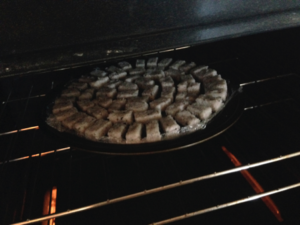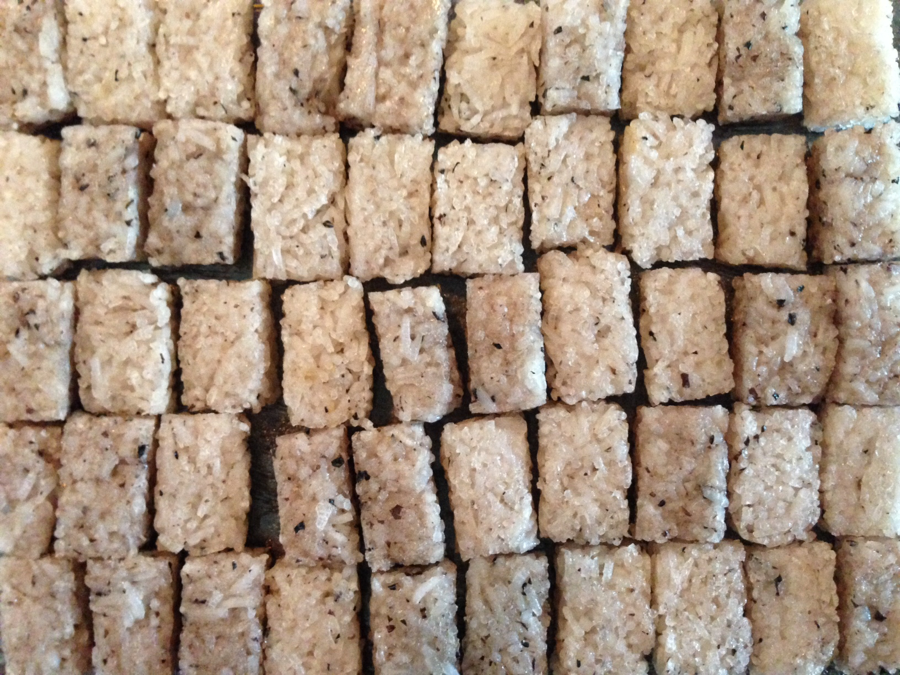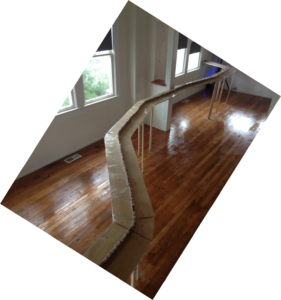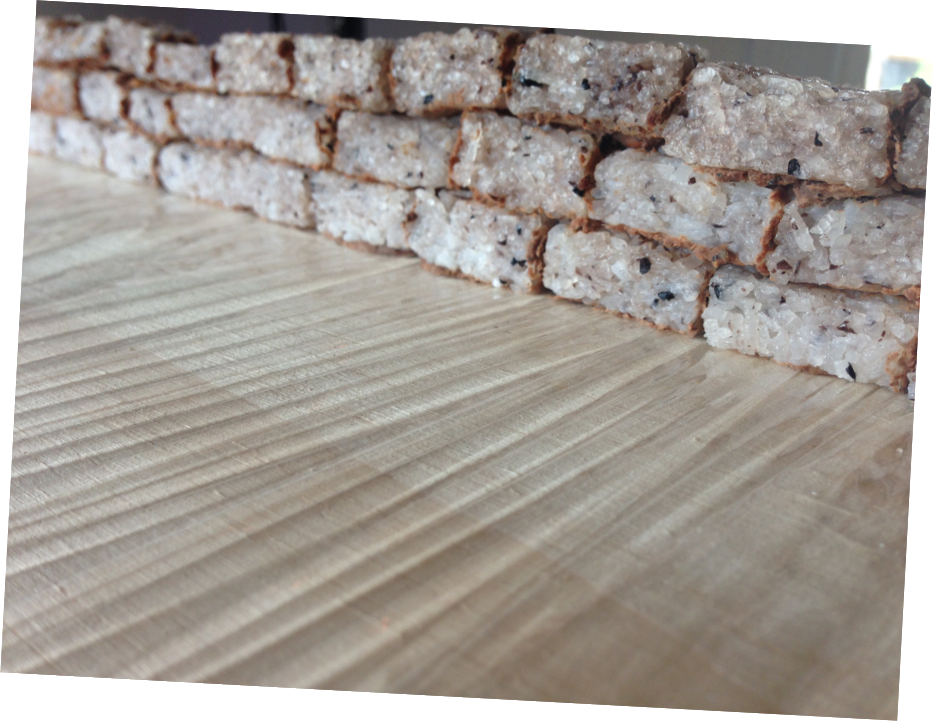Introduction
“In a world of uncertainty and confusion, a wall is something to rely on; something standing right there, in front of you—massive, firm, reassuring.”1
It is not without a little parody that I lay one tiny rice brick atop another, buttering on its sides a mortar of a paste made of refried bean. This continues brick by brick until over a thousand of them form a construction that snakes down the two front halls of Rhizome DC, an unpretentious, welcoming community art space fostering “art, learning, DIY culture” and “a home for non-mainstream (arts) programming.”2 My performance-installation sketch, #eatthatwall (working title), was one of several guest features for the opening of Natural Order, a mixed media exhibition by Costa-Rican/Mexican artist Paulina Velázquez Solís that abstracts the “deliriousness of (the human) mammalian.”3
This gutsy and humorous exhibition, and an artspace that geographically hugs the DC-Maryland border, made for the perfect venue to test out #eatthatwall. The project is an experiment with dissensus through mimicry, using food as an everyday, polysemic object to mock and disempower a structure that has become shorthand for Trump’s hardline on immigration.4 Guests of this exhibit were invited to participate in the construction and eating of the wall, and several did so. Delighted munching and finger-licking among the younger set soon waned to boredom from repetition. The adults, many regulars to Rhizome DC’s events, stayed on task only a little longer, gingerly tasting bricks and mortar, and chatting about this strange amalgamation of fabulist symbols between food and the border wall. Our conversations would circulate around the threats and promises encapsulated by the wall, deciphering who would want the wall’s existence and why, and imagining what other of our collective fears a wall might protect us from.
Philosopher Costica Bradatan poetically captures the socio-psychology of the wall in an essay in the New York Times:
“What a wall satisfies is not so much a material need as a mental one. Walls protect people not from barbarians, but from anxieties and fears, which can often be more terrible than the worst vandals. In this way, they are built not for those who live outside them, threatening as they may be, but for those who dwell within . . . A wall is above all the admission of a fundamental vulnerability.”5
The importance of creative imagination as a counterforce to these anxieties, fears, and vulnerabilities that warrant the need for a wall finds traction in Edward S. Casey and Mary Watkins’s research on art found along separation walls. They observe that “(b)order-wall art portrays marginalized points of view, critiques dominant messages, and not only posits alternate possibilities but creates them . . . art on the wall invites one in and brings one up close, creating an intimacy with the wall . . . Transgressively, the art uses the wall to begin to undo the wall itself.”6
In speculating whether feminist theatre demands feminist mimetic acts, theatre scholar Elin Diamond notes that mimesis might be a tool against “the complex, the different referents we want to see, even as we work to dismantle the mechanisms of patriarchal modeling.”7 #eatthatwall, like the other proposed borders by artists such as Jennifer Meridian, moves beyond using the wall as canvas or art-referenced structure. Collectively these artistic projects enact dissensus through an often humorous mimicry, dismantling the conventions of the border wall by proposing we construct imaginative models of fantastical, brazen, whimsical, or edible walls. 8 The miniature size of #eatthatwall evokes a lightened sense of playfulness, and suitably provides a means to grapple with the massiveness of the actual enterprise of sealing the US-Mexico border. The use of organic, fallible materials shaped into an alternative presentation of rice and beans becomes a vivid means to simultaneously depict and dismantle the imagined efficacy of the wall against border crossers, and simultaneously references the people from both sides who might eat such a sustaining dish.

The materials for the wall were chosen for their simplicity and historical relevance: a hybrid of ingredients with Mesoamerican roots (beans) and a familiar “New World” starch—and one close to my heart—introduced from Asia by the Spanish (rice).9 Food has been a central medium in my work with performance (beginning with re-stagings of playful, anti-dietetic Futurist banquets in 2009).10 A bearer of cultural and traditional narratives, and a marker of place and time, food and the rituals around it make for a highly performative signifier, and as Arjun Appadurai remarks, “a peculiarly powerful semiotic device . . . a marvelously plastic kind of collective representation” that derive from our need of it for our survival and its “capacity to mobilize strong emotions.” 11


It has proven a useful material when my work turned to explore migration, home, and belongings—a case of artistic research imitating nomadic life in a constant search of substitutions and surrogacies around comforts such as food. #eatthatwall could be seen as a continuation of this study of the affective and material nature of food in my recent performances: food co-mingled with inedible materials to produce symbolic relics in Unmade/Untitled (Singapore, 2016); food as a marker of difference between insider/outsider characters who inexplicably share a kitchen in Measures of Elsewhere (New Delhi, 2016) co-created with Bharatanatyam dancer Anusha Ravishankar; or a dish representing the multiple cultures present in a migrant’s home in Breakfast Elsewhere (various venues, 2016-present). In these projects, food and food-making are highlighted as sites for the practice of embodied knowledge. A performance of everyday politics ties these food-based choreographies to how we identify, remember, and belong to a place or people.
Jason De Leon’s enlightening research on migrant material culture, for example, has brought a keen eye to the clothing, bags, food, folk-cures, and water stocks that border-crossers carry and consume while making their way across the Arizona desert.12 This research—into foods with compelling narratives between and across the border, as well as the wall’s progress and other responses and protests to its slow manifestation—has spurred a few ideas for new potential materials for construction. One iteration might construct a wall out of discarded or used materials such as food packaging and remnants found on trails used by border crossers, another might examine the agricultural trade between the two countries by building the wall out of materials from potentially embargoed or surplus stocks.13
Score
Documenting #eatthatwall using the format of a performance score (below) creates a text of the experience of both process and product, and becomes a way to remember how to repeat this protest. The score will challenge me to keep close to the piece’s theme and questions as future iterations bring changes to continue to mimic the rise and eventual fall of the wall. For a short video documentation of the resulting construction at RhizomeDC, visit https://youtu.be/MpBz1HhSA_w. Video by Sorane Yamahira. Preservation copy at https://archive.org/details/eatthatwall

1.
Start with measuring
Measure distance.
Measure fear.
Measure scale.
Measure protection.
Measure depth.
Measure separation.
Measure truth justice.
Measure imagination.
Measure poverty.
Measure intentions.
Measure abandonment.
Measure sides but don’t take them.

2.
Build a wall
that’ll be a beautiful wall.
Scale it to defeat scale.
Shape it like a lego piece,
so anyone can help
build it, brick by brick.
They can lick the mortar off this
edible wall. Use materials that
are common, semiotically
abundant, meaningful.
Find gaps in existing boundaries
to seal with this unscale-able structure:
a figment of protection
by physical separation.
Above all, welcome all to
eat that wall…
(and do whatever happens after, naturally.)

3.
Sift satire from transcripts bearing alternate truth to collage nonsensical free verse, for instance:
Be intangible
intangible, physical, tall, power, beautiful southern border wall
Remember that, above and below14
Way ahead of schedule, way ahead of schedule.
Way, way, way ahead of schedule.15
Be “physically imposing in height,” towering at least 18ft above the border
Be impossible to breach with a ladder or grappling hooks and require at least an hour to breach with tools
Be sunk at least 6ft into the ground to prevent tunnelling
Blend in with the “surrounding environment” and be “aesthetically pleasing” from the north side
Include 25ft and 50ft gates for pedestrians and vehicles16
southern border, lots of sun, lots of heat.
Solar wall, panels, beautiful.
Pretty good imagination right?17
transparency. You have to
be able to see through it.
if you have people on the other side of the wall,
you don’t see them—they hit you on the head with
60 pounds of stuff?
It’s over.
As cray as that sounds, you need
transparency through that wall.18
Acknowledgements
With thanks to Sorane Yamahira, Akemi Maegawa / Anaba Projects, Paulina Velázquez Solís, Rhizome DC, and guests who participated.
Notes
- Costica Bradatan, “Scaling the ‘Wall in the Head,’” New York Times, November 27, 2011. ↩
- Rhizome DC, “About Us,” http://www.rhizomedc.org/about-rhizomedc. ↩
- Kriston Capps, “At Rhizome DC, Paulina Velázquez Solís’ Work Explores The Gross—and The Beautiful—Side of The Human Body,” Washington City Paper, May 11, 2017, https://www.washingtoncitypaper.com/arts/museums-galleries/blog/20861171/paulina-velzquez-sols-natural-order-at-rhizomedc-reviewed. ↩
- This despite broad public opinion that the wall should not be a prioritized defense against illegal immigration. See Rob Suls, “Less than Half the Public Views Border Wall as an Important Goal for U.S. Immigration Policy,” Pew Research Center, January 6, 2017. http://www.pewresearch.org/fact-tank/2017/01/06/less-than-half-the-public-views-border-wall-as-an-important-goal-for-u-s-immigration-policy. ↩
- Bradatan, “Scaling the ‘Wall in the Head.’” ↩
- Edward S. Casey and Mary Watkins, Up Against the Wall: Re-Imagining the U.S.-Mexico Border (Austin: University of Texas Press, 2014), 207–08. ↩
- Elin Diamond, “Mimesis, mimicry, and the ‘True-Real’,” Modern Drama 32, no. 1 (1989): 62. ↩
- Jennifer Meridian’s The Other Border Wall Proposals was submitted as an official bid to the US Customs and Border Control. This imaginative series, and works by other artists were covered by Adi Robertson, “The Border Wall Made of Pipe Organs isn’t Real, but it’s Still Getting Construction Offers,” The Verge, May 23, 2017, https://www.theverge.com/2017/5/23/15643318/jennifer-meridian-border-wall-hammock-pipe-organ-vendor-ads. See also Rafael Carranza and Arlene Martinez, “‘Game of Thrones,’ Great Wall of China Inspiration for Some Trump Border Wall Ideas,” USA Today Network, April 11, 2017, https://www.azcentral.com/story/news/politics/border-issues/2017/04/11/donald-trump-us-mexico-border-wall-ideas/100178138. The latter article has also been embedded with wall-related videos, including the prototypes that were erected in late October 2017 near a port of entry in San Diego, California, across Tijuana, Mexico. ↩
- John C. Super and Luis Alberto Vargas, “The History and Culture of Food and Drink in the Americas: Mexico and Highland Central America,” in The Cambridge World History of Food, ed. Kenneth F. Kiple and Kriemhild Coneè Ornelas (Cambridge: Cambridge University Press, 2000), 1250–53. ↩
- After restaging these performances (2009–2011), I was able to synthesize the practice and the theoretical with the help of Cecilia Novero’s book Antidiets of the Avant-Garde: From Futurist Cooking to Eat Art (Minneapolis: University of Minnesota Press, 2010). ↩
- Arjun Appadurai, “Gastro-politics in Hindu South Asia,” American Ethnologist 8, no. 3 (1981): 494. ↩
- Jason De León, “‘Better to Be Hot than Caught’: Excavating the Conflicting Roles of Migrant Material Culture,” American Anthropologist 114, no. 3 (2012): 477–95. ↩
- A few periodicals from the farming industry, along with mainstream media, have speculated on the effects the wall might have on food prices. See Sean Pratt, “Bean Importers Nervous as Trump Takes on Mexico,” The Western Producer, February 23, 2017, https://www.producer.com/2017/02/bean-importers-nervous-as-trump-takes-on-mexico and Brian Barth, “If Trump Builds the Wall, What Will Happen to our Food System?” Modern Farmer, January 10, 2017, https://modernfarmer.com/2017/01/trump-builds-wall-will-happen-food-system, the latter of which cites a 2014 report from the American Farm Bureau Federation. ↩
- “Transcript: Donald Trump’s full immigration speech, annotated,” LA Times, August 31, 2016, http://www.latimes.com/politics/la-na-pol-donald-trump-immigration-speech-transcript-20160831-snap-htmlstory.html. ↩
- Ryan Teague Beckwith, “Read a Transcript of President Trump’s CPAC Speech,” Time, February 24, 2017, http://time.com/4682023/cpac-donald-trump-speech-transcript. ↩
- “Solid Concrete Border Wall RFP,” FedBizOpps, May 12, 2017, https://www.fbo.gov/index?s=opportunity&mode=form&id=cff7de3dac2790e71966a823b73ec024&tab=core&_cview=1. ↩
- “Donald Trump talks up solar panel plan for Mexico wall,” BBC US & Canada, June 22, 2017, http://www.bbc.co.uk/news/world-us-canada-40363390. ↩
- Justin Sink and Elizabeth Titus, “Here’s the White House’s Transcript of What Trump Told Reporters Off the Record,” Bloomberg News, July 12, 2017, https://www.bloomberg.com/news/articles/2017-07-13/here-s-the-w-h-transcript-of-trump-s-off-the-record-press-chat. ↩